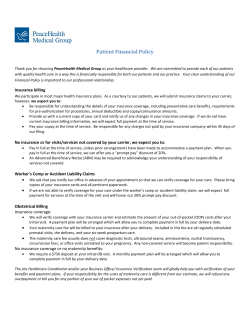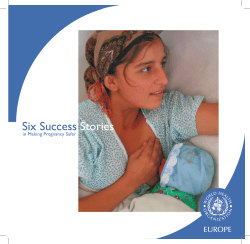
Preamble
Revenue Rulings Exemption for maternity & adoption leave pay Revenue Ruling PT.113 Preamble 1. Section 11 of the Pay-roll Tax Act 1971 (the PRT Act) exempts from pay-roll tax, wages paid or payable to employees on maternity leave or adoption leave. maternity leave, sick leave, recreational leave, annual leave or any similar leave taken in relation to the adoption is not exempt as it is not paid adoption leave. For the purposes of the exemption, the employee can take the leave before or after adoption. 2. The exemption: z applies to wages paid or payable on or after 1 January 2003 to female employees taking maternity leave and male and female employees taking adoption leave; z applies to all wages other than fringe benefits; z is limited to a maximum of 14 weeks pay; z applies irrespective of whether the leave is taken before or after the birth or adoption; and z must be supported by keeping relevant records. 3. The purpose of this ruling is to explain the application of the exemption for maternity and adoption leave pay and clarify the elements of the exemption. Ruling Definition of maternity leave – S.11(1)(a) PRT Act 4. Maternity leave is defined in the PRT Act as leave given to a female employee in connection with her pregnancy or the birth of her child. Sick leave, recreational leave, annual leave or any similar leave taken in connection with a pregnancy or the birth of a child is not considered as maternity leave for pay-roll tax purposes. For the purposes of the exemption, the employee can take the leave before or after the birth. Example In relation to the birth of her child, Mary took long service leave of 10 weeks, annual leave of four weeks and unpaid leave of 38 weeks. The wages paid for leave taken by Mary are taxable because the leave is not paid maternity leave. On the other hand, if Mary took long service leave of 10 weeks, annual leave of four weeks, paid maternity leave of 12 weeks and unpaid leave of 26 weeks, the wages paid for the 12 weeks maternity leave are exempt but the wages paid for the long service leave and annual leave are taxable. 5. The exemption does not apply to paternity leave which is granted to a male employee subsequent to his spouse (or de facto spouse) giving birth. Example John has taken paid adoption leave in three distinct parts, e.g. one week to familiarise himself with the adoption process, two weeks to go interstate/overseas to meet the child and a further three weeks after the child arrived in Melbourne. All six weeks are considered to be adoption leave. The wages paid in relation to the adoption leave are exempt because the exemption applies to leave taken before and after the adoption. The type of wages that both exemptions exclude 7. The exemption for both maternity and adoption leave applies to all wages paid to eligible employees other than fringe benefits. The exempt wages therefore include wages/salaries, employer superannuation contributions, allowances, bonuses and commissions. 8. Any fringe benefits provided to an employee taking maternity or adoption leave are not exempt under this provision. Maximum entitlement 9. However, for any one pregnancy or adoption, the exemption is limited to wages for a maximum of 14 weeks full time leave for a full time employee or the equivalent amount if taken over a longer period e.g. 28 weeks leave being paid at half pay. In the case of a part-time employee, the exemption is limited to a maximum of 14 weeks leave paid at the applicable part-time pay rates. Examples i. Cathy, a part-time employee, works 3 days a week at the rate of $100 per day. The maximum amount of exempt wages that can be paid to Cathy is $4,200 i.e. ($100 x 3 x 14). ii. ABC Pty Ltd has a 12 weeks paid maternity leave policy. Stella, a full time employee elects to take the maternity leave over 24 weeks at half pay. Under the exemption, these wages are fully exempt. Definition of adoption leave – S.11(1)(b) PRT Act Commencement date of exemption 6. Adoption leave refers to leave given to an employee in connection with the adoption of a child. As with 10. Irrespective of when the leave is taken, the wages paid in respect of the maternity or adoption leave are exempt only if paid on or after 1 January 2003. Ruling No. PT.113 Examples i. XYZ Pty Ltd has a policy to pay 12 weeks maternity leave as a lump sum to an employee upon returning to work for a minimum period of six months after the birth. If Elizabeth took the leave before 1 January 2003 and the lump sum was paid after 1 January 2003, XYZ Pty Ltd is entitled to a paid maternity leave exemption of 12 weeks. ii. Cynthia was paid 12 weeks maternity leave as a lump sum on 1 December 2002 when she commenced her maternity leave. The employer, DEF Pty Ltd, is not entitled to the exemption for paid maternity leave as the amount was paid before the commencement date of the exemption. This is notwithstanding that some of the leave was taken after 1 January 2003. Leave verification 11. To substantiate entitlement to the maternity leave exemption, an employer must obtain and keep for a period of five years a medical certificate or statutory declaration from the employee section 11(6) of the PRT Act. These documents must specify or state that the employee is or was pregnant, or that the employee has given birth and the date of birth. 12. To substantiate entitlement to the adoption leave exemption, an employer must keep for a period of five years a statutory declaration from the employee stating that a child has been placed in the employee's custody pending the making of an adoption order or that an adoption order has been made or recognised in the employee's favour section 11(7) of the PRT Act. Please note that rulings do not have the force of law. Each decision made by the State Revenue Office is made on the merits of each individual case having regard to any relevant ruling. All rulings must be read subject to Revenue Ruling GEN.01. April 2005 Commissioner of State Revenue Ruling No. PT.113
© Copyright 2025





















